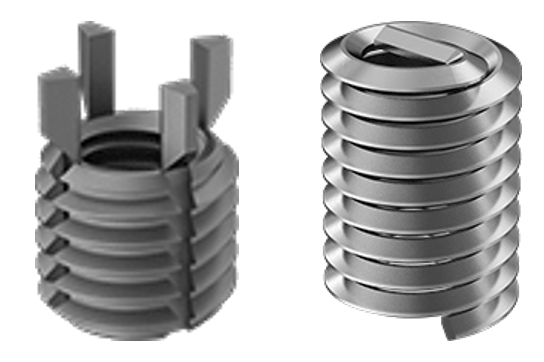Helical vs Key-Locking Inserts
Explain some typical advantages/disadvantages of Helical vs Key-Locking inserts.

Expand Hint
A threaded insert is a fastener element usually inserted into an object to add a threaded hole. The purpose of the threaded hole generally include repairing damaged/stripped threads, strengthen threads against failures due to corrosion (dissimilar/galvanic), and converting thread/hole sizes.
Hint 2
Helical inserts (right image) are precision-formed continuous wire coils that provide permanent, wear-resistant threads that typically have tang to assist with installation, which is a prong on one end that is removed after installation. Key-Locking inserts (left image) is a solid bushing style insert with both internal and external threads with "keys" or wedges attached to the top. Once installed, the keys are hammered down into the external thread grooves, creating a permanent lock against rotation.
A threaded insert is a fastener element usually inserted into an object to add a threaded hole. The purpose of the threaded hole generally include repairing damaged/stripped threads, strengthen threads against failures due to corrosion (dissimilar/galvanic), and converting thread/hole sizes.
Helical inserts (right image) are precision-formed continuous wire coils that provide permanent, wear-resistant threads that typically have tang to assist with installation, which is a prong on one end that is removed after installation. Key-Locking inserts (left image) is a solid bushing style insert with both internal and external threads with "keys" or wedges attached to the top. Once installed, the keys are hammered down into the external thread grooves, creating a permanent lock against rotation.
- Key-Locking inserts are optimal for in situations where fasteners are repeatedly removed and reassembled.
- Key-Locking inserts are optimal for high temperature and torque situations. They are usually stronger than Helical wire inserts.
- Key-Locking inserts do not require special install tools, unlike Helicals, and are generally easier to install and remove.
- If a Key-Locking insert is removed, the existing hole can be reused to install a new insert.
- Helical inserts are typically less expensive than Key-Locking, and are optimal for minimizing space.
- Helical inserts have an increased FOD (Foreign Object Damage) concern due to the necessary tang/prong removal to complete installation.
- Key-Locking inserts are optimal for in situations where fasteners are repeatedly removed and reassembled.
- Key-Locking inserts are optimal for high temperature and torque situations. They are usually stronger than Helical wire inserts.
- Key-Locking inserts do not require special install tools, unlike Helicals, and are generally easier to install and remove.
- If a Key-Locking insert is removed, the existing hole can be reused to install a new insert.
- Helical inserts are typically less expensive than Key-Locking, and are optimal for minimizing space.
- Helical inserts have an increased FOD (Foreign Object Damage) concern due to the necessary tang/prong removal to complete installation.
Time Analysis
See how quickly you looked at the hint, solution, and answer. This is important for making sure you will finish the FE Exam in time.- Hint: Not clicked
- Solution: Not clicked
- Answer: Not clicked